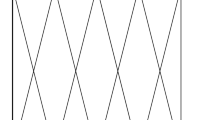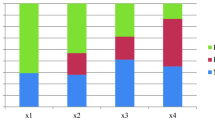Abstract
Interval rough numbers play an important role in dealing with complex fuzzy relationships. In this paper, a group decision-making (GDM) model based on interval rough multiplicative reciprocal (IRMR) matrix is proposed. Firstly, the inconsistency, satisfactory consistency and complete consistency of the IRMR matrix are defined from the perspective of set theory. Secondly, an improved method for the inconsistent IRMR matrix is introduced to address the inconsistent preference matrix in GDM. We define the uniform approximation matrix of the IRMR matrix, prove its existence, and provide a new calculation method for the sorting vector of IRMR matrix. Finally, the multiplicative reciprocal matrix obtained with a weighted geometric operator assembly is still the IRMR matrix. A GDM algorithm of the IRMR matrix is presented. The proposed algorithm is demonstrated using an illustrative example, and its feasibility and effectiveness are verified through comparison with other existing methods.



Similar content being viewed by others
References
Kim, S.H., Choi, S.H., Kim, J.K.: An interactive procedure for multiple attribute group decision making with incomplete information: range-based approach. Eur. J. Oper. Res. 118(2), 139–152 (1999)
Ning, C.G.: Consistency research of uncertain judgement matrix. Guangxi university, Nanning (2017)
Lv, Y.J., Shi, W.L., Guo, X.R.: The conditions of rank preservation and a general priority formula for fuzzy complementary judgement matrix. Math. Pract. Theory 39(15), 153–158 (2009)
Gong, Z.W., Guo, W.W., Herrera-Viedma, E., Gong, Z.J., Wei, G.: Consistency and consensus modeling of linear uncertain preference relations. Eur. J. Oper. Res. 283(1), 290–307 (2020). https://doi.org/10.1016/j.ejor.2019.10.035
Liu, X., Xu, Y.J., Herrera, F.: Consensus model for large-scale group decision making based on fuzzy preference relation with self-confidence: detecting and managing overconfidence behaviors. Inf. Fus. 52, 245–256 (2019). https://doi.org/10.1016/j.inffus.2019.03.001
Xu, Z.S., Liao, H.C.: Intuitionistic Fuzzy Analytic Hierarchy Process. IEEE Trans. Fuzzy Syst. 22(4), 749–761 (2014). https://doi.org/10.1109/tfuzz.2013.2272585
Nie, R.X., Wang, J.Q.: Prospect theory-based consistency recovery strategies with multiplicative probabilistic linguistic preference relations in managing group decision making. Arab. J. Sci. Eng. 45(3), 2113–2130 (2020). https://doi.org/10.1007/s13369-019-04053-9
Zhang, X.Y., Zhang, H.Y., Wang, J.Q.: Discussing incomplete 2-tuple fuzzy linguistic preference relations in multi-granular linguistic MCGDM with unknown weight information. Soft. Comput. 23(6), 2015–2032 (2019)
Nie, R.X., Tian, Z.P., Wang, J.Q., Luo, H.Y.: An objective and interactive-information-based feedback mechanism for the consensus-reaching process considering a nonsupport degree for minority opinions. Expert Syst. (2020). https://doi.org/10.1111/exsy.12543
Liu, F., Zhang, W.G., Zhang, L.H.: A group decision making model based on a generalized ordered weighted geometric average operator with interval preference matrices. Fuzzy Sets Syst. 246, 1–18 (2014). https://doi.org/10.1016/j.fss.2013.07.010
Lv, Y.J., Yang, Y.H.: Analytic hierarchy process based on interval rough number. Syst. Eng. Theory Pract. 38(3), 786–793 (2018)
Gong, Z.W., Li, L.S., Forrest, J., Zhao, Y.: The optimal priority models of the intuitionistic fuzzy preference relation and their application in selecting industries with higher meteorological sensitivity. Expert Syst. Appl. 38(4), 4394–4402 (2011). https://doi.org/10.1016/j.eswa.2010.09.109
Wan, S.P., Wang, F., Dong, J.Y.: A three-phase method for group decision making with interval-valued intuitionistic fuzzy preference relations. IEEE Trans. Fuzzy Syst. 26(2), 998–1010 (2018). https://doi.org/10.1109/tfuzz.2017.2701324
Nie, R.X., Wang, J.Q., Wang, T.L.: A three-cycle decision-making selection mechanism with intuitionistic trapezoidal fuzzy preference relations. J. Intell. Fuzzy Syst. 36(6), 5409–5422 (2019). https://doi.org/10.3233/jifs-181306
Qazi, K.I., Lam, H.K., Xiao, B., Ouyang, G., Yin, X.: Classification of epilepsy using computational intelligence techniques. CAAI Trans. Intell. Technol. 1(2), 137–149 (2016). https://doi.org/10.1016/j.trit.2016.08.001
Li, J., Wang, J.Q., Hu, J.H.: Consensus building for hesitant fuzzy preference relations with multiplicative consistency. Comput. Ind. Eng. 128, 387–400 (2019). https://doi.org/10.1016/j.cie.2018.12.051
Zhu, B., Xu, Z.S., Xu, J.P.: Deriving a ranking from hesitant fuzzy preference relations under group decision making. IEEE Trans. Cybern. 44(8), 1328–1337 (2014). https://doi.org/10.1109/TCYB.2013.2283021
Pawlak, Z.: Rough set approach to knowledge-based decision support. Eur. J. Oper. Res. 99(1), 48–57 (1997)
Pamučar, D., Mihajlović, M., Obradović, R., Atanasković, P.: Novel approach to group multi-criteria decision making based on interval rough numbers: hybrid DEMATEL-ANP-MAIRCA model. Expert Syst. Appl. 88, 58–80 (2017). https://doi.org/10.1016/j.eswa.2017.06.037
Pamučar, D., Stević, Ž., Zavadskas, E.K.: Integration of interval rough AHP and interval rough MABAC methods for evaluating university web pages. Appl. Soft Comput. 67, 141–163 (2018). https://doi.org/10.1016/j.asoc.2018.02.057
Kong, Z.J., Zhao, X.T., Li, B., Geng, L.S.: Interval rough number DEMATEL decision method considering different expert preferences. Manuf. Autom. 41(5), 66–69 (2019)
Tian, C., Peng, J.J., Zhang, W.Y., Zhang, S., Wang, J.Q.: Tourism environmental impact assessment based on improved AHP and picture fuzzy PROMETHEE II methods. Technol. Econ. Dev. Econ. 26(2), 355–378 (2019). https://doi.org/10.3846/tede.2019.11413
Wei, X.J.: Obtaining weight vector of interval number judgment matrix based on preference information and its application in agricultural internet of things. Revista de la Facultad de Agronomia de la Universidad del Zulia. 36(1), 140–149 (2019)
Liang, R.X., Wang, J.Q., Zhang, H.Y.: A multi-criteria decision-making method based on single-valued trapezoidal neutrosophic preference relations with complete weight information. Neural Comput. Appl. 30(11), 3383–3398 (2018). https://doi.org/10.1007/s00521-017-2925-8
Yue, Q., Fan, Z.P.: Consistency analysis and ranking method for interval reciprocal judgement matrices. J. Syst. Eng. 25(4), 459–466 (2010)
Fan, Q.H., Liu, B.X., Zhang, Y.H., Zhou, R.Y.: An algorithm of improving the consistence of the positive reciprocal matrix based on relative error. In: International Conference on Information Computing and Applications. Springer, Berlin, Heidelberg. 12(1), 177–183 (2011)
Meng, F.Y., Zeng, X.L.: A new method for judgement matrix consistency rectification. Stat. Decis. 15(3), 134–135 (2007). https://doi.org/10.13546/j.cnki.tjyjc.2007.15.035
Liu, T.C., Li, Z.F.: Improved method of inconsistent interval reciprocal judgment matrix. Fuzzy Syst. Math. 31(4), 117–123 (2017)
Wang, X.H., Qin, X.Z., Yang, D.L.: The pattern recognition method for correcting the judgment matrix into one with complete uniformity in AHP. Syst. Eng. Theory Pract. 17(11), 56–59 (1997)
Liu, W.L., Lei, Z.J.: Study on rectification method for the judgment matrix in AHP. Syst. Eng. Theory Pract. 17(6), 30–34 (1997)
Arbel, A.: Approximate articulation of preference and priority derivation. Eur. J. Oper. Res. 43(1), 317–326 (1989)
Wei, C.P., Zhang, Y.Z., Feng, X.Q.: Deriving weights from interval comparison matrics based on consistency test. Syst. Eng. Theory Pract. 27(10), 132–139 (2007)
Mikhailov, L.: A fuzzy approach to deriving priorities from interval pairwise comparison judgements. Eur. J. Oper. Res. 159(3), 687–704 (2004). https://doi.org/10.1016/s0377-2217(03)00432-6
Yang, Q., Du, P.A., Wang, Y., Liang, B.: Developing a rough set based approach for group decision making based on determining weights of decision makers with interval numbers. Oper. Res. Int. J. 18(3), 757–779 (2017). https://doi.org/10.1007/s12351-017-0344-3
Yue, Z.L.: A method for group decision-making based on determining weights of decision makers using TOPSIS. Appl. Math. Model. 35(4), 1926–1936 (2011). https://doi.org/10.1016/j.apm.2010.11.001
Abootalebi, S., Hadi-Vencheh, A., Jamshidi, A.: An Improvement to determining expert weights in group multiple attribute decision making problem. Group Decis. Negot. 27(2), 215–221 (2018). https://doi.org/10.1007/s10726-018-9555-0
Alias, F.M.A., Abdullah, L., Gou, X.J., Liao, H.C., Herrera-Viedma, E.: Consistent fuzzy preference relation with geometric Bonferroni mean: a fused preference method for assessing the quality of life. Appl. Intell. 49(7), 2672–2683 (2019). https://doi.org/10.1007/s10489-019-01415-6
Li, J., Zhang, Y.L.: A novel method for aggregating interval multiplicative comparison matrices and its application in ranking alternatives. J. Intell. Fuzzy Syst. 35(3), 3675–3684 (2018). https://doi.org/10.3233/jifs-18455
Tian, Z.P., Nie, R.X., Wang, J.Q., Zhang, H.Y.: A two-fold feedback mechanism to support consensus-reaching in social network group decision-making. Knowl. Based Syst. 162, 74–91 (2018). https://doi.org/10.1016/j.knosys.2018.09.030
Zhang, X.Y., Wang, X.K., Yu, S.M., Wang, J.Q., Wang, T.L.: Location selection of offshore wind power station by consensus decision framework using picture fuzzy modelling. J. Clean. Prod. 202, 980–992 (2018). https://doi.org/10.1016/j.jclepro.2018.08.172
Tian, Z.P., Nie, R.X., Wang, J.Q.: Social network analysis-based consensus-supporting framework for large-scale group decision-making with incomplete interval type-2 fuzzy information. Inf. Sci. 502, 446–471 (2019). https://doi.org/10.1016/j.ins.2019.06.053
Meng, F.Y., Tang, J., An, Q.X., Chen, X.H.: Decision making with intuitionistic linguistic preference relations. Int. Trans. Oper. Res. 26(5), 2004–2031 (2017). https://doi.org/10.1111/itor.12383
Zeng, L., Zeng, X.Y.: Research on a class of multiple attribute decision making method with interval rough numbers. Control Decis. 25(11), 1757–1760 (2010). https://doi.org/10.13195/j.cd.2010.11.159.zengl.028
Weng, S.Z., Lv, Y.J.: Sorting method with interval rough number and its application. J. Nanjing Univ. 51(4), 818–825 (2015)
Xia, X.D., Lv, Y.J.: Method based on MADM of interval rough numbers with parameters. Comput. Eng. Appl. 53(5), 255–259 (2017). https://doi.org/10.3778/j.issn.1002-8331.1608-0022
Xie, F.P., Zeng, X.L., Duan, Y.Y.: Priority method for complementary judgement matrix based on interval rough number. J. Qiongzhou Univ. 22(5), 22–26 (2015)
He, C.L.: The study on some problems of multi-attribute decision making that based on interval rough numbers. Guangxi University, Nanning (2014)
Wei, L.Y.: The rectification method and sequencing algorithm of the inconsistent interval number judgment matrix. J. Guangxi Univ. Natl. 3(2), 1–4 (2003)
Huang, R.L., Tian, Z.J., Lv, Y.J.: Research on the consistency of interval rough number reciprocal judgment matrix. Fuzzy Syst. Math. 33(4), 124–133 (2019)
Slowinski, R., Vanderpooten, D.: A generalized definition of rough approximations based on similarity. IEEE Trans. Knowl. Data Eng. 12(2), 331–336 (2000)
Saaty, T.L.: The Analytic Hierarchy Process. McGraw-Hill Inc, Pennsylvania (1980)
Liu, B.D.: Theory and Practice of Uncertain Programming, vol. 5, 21st edn, pp. 64–66. Springer, Berlin Heidelberg (2009)
Jin, Z.W., Guo, H.: Research on multiple attribute decision making method based on ideal point with interval rough numbers. J. Chongqing Univ. Technol. 27(5), 114–117 (2013)
Qian, W.Y., Zeng, Z.: Method for ranking interval rough numbers based on possibility degree. Oper. Res. Manag. Sci. 22(1), 71–76 (2013)
Wang, L.F., Xu, S.B.: Introduction to Analytic Hierarchy Process. Renmin University of China, Beijing (1990)
Rudin, W.: Principles of Mathematical Analysis. McGraw-hill, New York (1964)
Wei, Z.Z., Wei, L.Y.: The consistent interval number judgement matrix and its characteristics. J. Guangxi Univ. Technol. 11(4), 17–20 (2000)
Meng, F.Y., An, Q.X., Tan, C.Q., Chen, X.H.: An approach for group decision making with interval fuzzy preference relations based on additive consistency and consensus analysis. IEEE Trans. Syst. Man Cybern. Syst. 47(8), 2069–2082 (2017)
Tu, Z.K.: Some Properties of Intuitionistic Judgment Matrix and Interval Complementary Judgment Matrix. Hefei University of Technology, Hefei (2015)
Acknowledgements
We would like to thank the editors and anonymous reviewers for their valuable comments and suggestions. This work was supported by the National Natural Science Foundation of China (No. 71871228).
Author information
Authors and Affiliations
Corresponding author
Rights and permissions
About this article
Cite this article
Huang, Rl., Zhang, Hy., Peng, Jj. et al. Group Decision-Making Based on Set Theory and Weighted Geometric Operator with Interval Rough Multiplicative Reciprocal Matrix. Int. J. Fuzzy Syst. 22, 1815–1831 (2020). https://doi.org/10.1007/s40815-020-00900-2
Received:
Revised:
Accepted:
Published:
Issue Date:
DOI: https://doi.org/10.1007/s40815-020-00900-2




